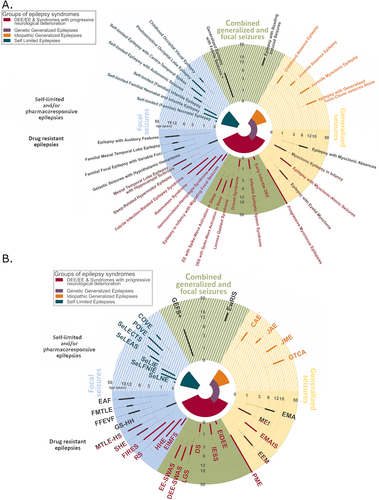3D figure of epilepsy syndromes
Abstract
We propose an instructive figure that summarized the classification of epilepsy syndromes according to the 2022 report of the ILAE Task Force on Nosology and Definitions. Our aim is to present on the same figure different concepts such as the names of epilepsy syndromes, their extreme and classical ages of onset, their epilepsy types (generalized, focal, or generalized and focal) but also their membership in groups of epilepsy syndromes as for self-limited or developmental and epileptic encephalopathies. With this figure, we provide an interactive tool, as supplementary data, helping to present this classification and link it to electro-clinical mandatory, alerts, and exclusionary criteria of each syndrome, in accordance with the ILAE position papers on syndromes classification and nosology. This report may be used as an illustrative tool for teaching epilepsy syndromes and as a practical and comprehensive aid for the classification of epilepsy individuals' syndromes.
The production of instructive figures that summarize complex concepts, such as classification of epilepsy syndromes for the education of epileptologists, general practitioners, and patients and their families can be very challenging. We propose the following figure (Figure 1) to illustrate in a single comprehensive graphic representation the various epilepsy syndromes, maintaining consistency with the 2017 ILAE Classification of the Epilepsies paper1 and of the ILAE Task Force on Nosology and Definitions position papers in 2022.2-6

This proposed multilevel figure considers the new terminology used in the position papers and encompasses several dimensions.
First, we classified the epilepsy syndromes according to epilepsy type as reported in the ILAE classification, namely focal, generalized, and combined generalized and focal.1 Second, we used a concentric scale to illustrate the age of onset of the different epilepsy syndromes, an important criterion reported in the definition of the syndromes. By using a continuous logarithmic scale and not only a qualitative one, we were also able to go beyond childhood including variable age syndromes and syndromes with adult onset. We detailed the extreme range of onset age using dotted lines and the classical age range using a solid line. Third, to identify and visualize the different groups of epilepsy syndromes as per the position papers,2-6 we filled the groups with specific color (red for developmental and/or epileptic encephalopathies and syndromes with progressive neurological deterioration, turquoise for self-limited epilepsies, orange for idiopathic generalized epilepsies, and pink for genetic generalized epilepsies). Finally, we added the self-limited dimension separating the figure into two blocks, self-limited often drug-responsive epilepsies with white diagonal hatching versus drug-resistant epilepsies and acknowledge that the separation might not be always very clear.
In conclusion, this figure can be used to succinctly illustrate the entire classification but might be also parcellated according to the user's needs. It can be an illustrative tool for teaching epilepsy syndromes and can also be used as a practical aid for syndrome classification of patients.
ACKNOWLEDGMENT
RN acknowledges GEEN-DS chair position institut lmagine is supported by FAMA Fund hosted by Swiss Philanthropy Foundation.
CONFLICT OF INTEREST
None of the authors has any conflict of interest to disclose related to this study. We confirm that we have read the Journal's position on issues involved in ethical publication and affirm that this report is consistent with those guidelines.




